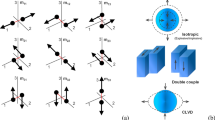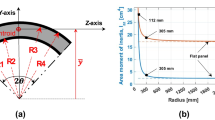Abstract
The micro structure of the aggregate-mortar interface is directly related to the macroscopic properties of cement-based materials, but it is difficult to measure the deformation and macroscopic characteristics by using traditional methods. In order to study the feature of the shear failure process of aggregate-mortar interface and to analyze its damage mechanism, the whole shear damage processes of interface specimens for granite-mortar are monitored by the full-digital acoustic emission (AE) acquisition system. Based on the statistic’s analysis of AE signals associated with interface damage processes comprehensively, typical AE characteristics are summed up from the aspect of accumulation characteristics of AE signals and time history plots of single AE parameters to distribution analysis of combined AE parameters. The research result is of great reference value for further recognition of physical mechanism for concrete damage processes and for a deep understanding of aggregate-mortar interfacial damage mechanism.
Similar content being viewed by others
References
Wang, Z.M., Kwan, A.K.H., and Chan, H.C., Mesoscopic study of concrete I: generation of random aggregate structure and finite element mesh, Computers and Structures, 1999, vol. 70, p. 533–544.
Wang, Z.L., Gu, X.L., and Lin, F., Experimental study on mechanical performance of interface between mortar and aggregate in concrete, Proc. Earth and Space 2010: Engineering, Science, Construction, and Operations in Challenging Environments, ASCE, 2010, pp. 3529–3536.
Walter, R., Ostergaard, L., and Olesen, J.F., Wedge splitting test for a steel-concrete interface, Engineering Frac–ture Mechanics, 2005, vol. 72, no. 17, pp. 2565–2583.
Shah, S.G., Ray, S., and Chandra Kishen, J.M., Fatigue crack propagation at concrete-concrete bi-material interfaces, International Journal of Fatigue, 2014, vol. 63, pp. 118–126.
Tu, X.Q., Zhang, Y.F., and Liu, H., Effect of interface elastic modulus on damage mechanism of the fiber rein–forced concrete, Advanced Materials Research, 2012, vol. 450, pp. 1562–1566.
Shah, S.G. and Chandra Kishen, J.M., Fracture behavior of concrete-concrete interface using acoustic emis–sion technique, Engineering Fracture Mechanics, 2010, vol. 77, no. 6, pp. 908–924.
Santos, D.S., Santos, P., and Dias-da-Costa, D., Effect of surface preparation and bonding agent on the con–crete-to-concrete interface strength, Construction and Building Materials, 2012, vol. 37, pp. 102–110.
Buyukozturk, O. and Lee, K., Interface fracture mechanics of concrete composites Proceedings of international conference on fracture mechanics of concrete structures, Elsevier Applied Science, Breckenridge, 1992, pp. 163–168.
Tschegg, E.K., Rotter, H.M., and Roelfstra, P.E., Fracture mechanical behavior of aggregate-cement matrix interfaces, Mater. Civil Engineering, 1995, vol. 7, no. 4, pp. 199–203.
Buyukozturk, O. and Hearing, B., Crack propagation in concrete composites influenced by interface fracture parameters, Solids Struct., 1998, vol. 35, no. 31, pp. 4055–4066.
Mitsui, K., Li, Z., and Lange, D., Relationship between microstructure and mechanical properties of the paste–aggregate interface, ACI Mater. J., 1994, vol. 91, no.1, pp. 30–39.
Chandra Kishen, J.M. and Saouma, V.E., Fracture of rock-concrete interfaces: laboratory tests and applica–tions, ACI Struct. J., 2004, vol. 101, no. 3, pp. 325–331.
Harmuth, H., Investigation of the adherence and the fracture behaviour of polymer cement concrete, Cem. Concr. Res., 1995, vol. 25, no. 3, pp. 497–502.
Kunieda, M., Kurihara, N., and Uchida, Y., Application of tension softening diagrams to evaluation of bond properties at concrete interfaces, Engineering Fracture Mechanics, 2000, vol. 65, no. 2, pp. 299–315.
Caliskan, S., and Karihaloo, B.L., Effect of surface roughness, type and size of model aggregates on the bond strength of aggregate-mortar interface, Interface Science, 2004, vol. 12, no. 4, pp. 361–374.
Rao, G.A. and Prasad, B.K., Influence of type of aggregate and surface roughness on the interface fracture prop–erties, Materials and Structures, 2004, vol. 37, no. 5, pp. 328–334.
Rao, G.A. and Prasad, B.K., Influence of the roughness of aggregate surface on the interface bond strength, Cement and Concrete Research, 2002, vol. 32, no. 2, pp. 253–257.
Appa Rao, G. and Raghu Prasad, B.K., Influence of type of aggregate and surface roughness on the interface fracture properties, Materials and Structures, 2004, vol. 37, no. 5, pp. 328–334.
Taylor, M.A. and Broms, B.B., Shear bond strength between coarse aggregate and cement paste or mortar, Proc. ACI Journal, ACI, 1964, vol. 61, no. 8.
Mangat, P.S. and O’Flaherty, F.J., Influence of elastic modulus on stress redistribution and cracking in repair patches, Cement and Concrete Research, 2000, vol. 30, no. 1, pp. 125–136.
Fang, C., Lundgren, K., and Chen, L., Corrosion influence on bond in reinforced concrete, Cement and Concrete Research, 2004, vol. 34, no. 11, pp. 2159–2167.
Shi, Z., Cui, C., and Zhou, L., Bond decay at bar-concrete interface under variable fatigue loads, European Journal of Mechanics-A/Solids, 2006, vol. 25, no. 5, pp. 808–818.
Yang, W. and Liu, H., Effect of interfacial strength on bending properties of reinforced concrete beams, Journal of Wuhan University of Technology, Mater. Sci. Ed., 2013, vol. 28, no. 6, pp. 1161–1166.
Wu, Z.J. Fiber composites interface mechanics representation and parameters determination, The Journal of Composite Materials, 1996, vol. 13, no. 1, p. 86.
Invernizzi, S., Lacidogna, G., and Carpinteri, A., Scaling of fracture and acoustic emission in concrete, Maga–zine of Concrete Research, 2013, vol. 65, no. 9, pp. 529–534.
Wang, G.S., Hu, S.L., and Liu, H.X., The failure process for acoustic emission monitoring of rock concrete interface, Mining Engineering, 2006, vol. 4, pp. 22–24.
Sagar, R.V., Prasad, B.K., and Kumar, S.S., An experimental study on cracking evolution in concrete and cement mortar by the b-value analysis of acoustic emission technique, Cement and Concrete Research, 2012, vol. 42, no. 8, pp. 1094–1104.
Zhu, Y.C., The Experiment on the Study of Mechanics Performance of the Interfaces Between Concrete and Mortar, The Dalian University of Technology, 2011.
Van der Pluijm, R., Rutten, H., and Ceelen, M., Shear behaviour of bed joints, Proc. 12 th Int. Brick. Block Masonry Conf., 2000, vol. 3, p. 1849–1862.
Moradian, Z.A., Ballivy, G., and Rivard, P., Application of acoustic emission for monitoring shear behavior of bonded concrete-rock joints under direct shear test, Canadian Journal of Civil Engineering, 2012, vol. 39, no. 8, pp. 887–896.
Moradian, Z.A., Ballivy, G., and Rivard, P., Evaluating damage during shear tests of rock joints using acoustic emissions, International Journal of Rock Mechanics and Mining Sciences, 2010, vol. 47, no. 4, pp. 590–598.
Chinese’s invention patents', Test method and device of the aggregate-mortar transition zone’s dynamic shear characteristic' (Publication No. CN102226745A).
Wang, Y., Experimental Study on Damage Mechanism of Concrete Based on Acoustic Emission Technology, Hohai University, 2009.
Invernizzi, S., Lacidogna, G., and Carpinteri, A., Scaling of fracture and acoustic emission in concrete, Magazine of Concrete Research, 2013, vol. 65, no. 9, pp. 529–534.
Author information
Authors and Affiliations
Corresponding author
Additional information
The article is published in the original.
Rights and permissions
About this article
Cite this article
Wang, Y., Chen, S.J., Zhao, H.T. et al. Acoustic emission characteristics of interface between aggregate and mortar under shear loading. Russ J Nondestruct Test 51, 497–508 (2015). https://doi.org/10.1134/S1061830915080094
Received:
Published:
Issue Date:
DOI: https://doi.org/10.1134/S1061830915080094




